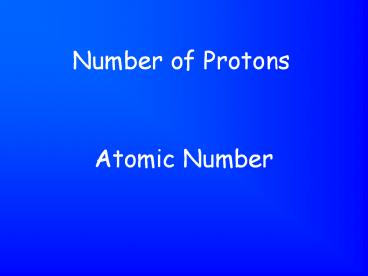Atomic Number PowerPoint PPT Presentation
Title: Atomic Number
1
Atomic Number
- Number of Protons
2
Mass Number
- Number of Protons Neutrons
3
C-12 or carbon-12
- 12 is the mass number.
4
12C
- Left Superscript mass number
6
5
12C
- Left Subscript atomic number
6
6
80Br
- 35
35
Atomic Number ?
7
20Ne
- 20
10
Mass Number ?
8
238U
- 238
92
Mass Number ?
9
27Al
- 27
13
Mass Number ?
10
40Ca
- 20
20
Atomic Number ?
11
19F
- 9
9
Atomic Number ?
12
U-235
- Mass Number 235
- Atomic Number 92 (Look up!)
Mass Number? Atomic Number?
13
C-14
- Mass Number 14
- Atomic Number 6 (Look up!)
- Number of neutrons 14 - 6 8
How many neutrons?
14
Isotope
- Atoms of the same element with a different of
neutrons
15
Isotope
- Atoms with the same atomic but different mass
16
Characteristics of Proton
- Charge 1, mass 1 amu, location inside
nucleus
17
Characteristics of Neutron
- Charge 0, mass 1 amu, location inside
nucleus
18
Characteristics of Electron
- Charge -1, mass 1/1836 amu or 0.0005 amu,
location outside nucleus
19
Ion
- An atom that has gained or lost electrons so
carries charge
20
Nucleons
- Protons Neutrons
21
atom
- Smallest bit of an element that retains the
properties of the element.
22
atom
- Electrically neutral.
- of protons of electrons.
23
Charge
- protons - electrons
24
of neutrons
- Mass number atomic number
25
14C
- 8
6
of neutrons ?
26
9Be
- 5
4
of neutrons ?
27
40Ar
- 22
18
of neutrons ?
28
15N
- 8
7
of neutrons ?
29
24Mg
- Right superscript charge
2
12
30
24Mg
- 10 electrons
2
12
of electrons?
31
86Rb
- 36 electrons
1
37
of electrons?
32
127Te
- 53 electrons
1-
52
of electrons?
33
32S
- 18 electrons
2-
16
of electrons?
34
20F
- 9 protons, 11 neutrons, 10 electrons
-
9
of protons, neutrons, electrons?
35
Cation
- Positive ion atom lost electrons
36
Anion
- Negative ion atom gained electrons
37
Avg. Atomic Mass
- Weighted avg. of masses of naturally occurring
isotopes of an element.
38
2 isotopes of Cl 75 Cl-35 25
Cl-37.Calculate avg. atomic mass.
- Avg. atomic mass
- .75(35) .25(37) 35.5 amu
39
Daltons Model
- Billiard Ball Model
40
Thomsons Model
- Plum Pudding Model
-
-
-
-
-
41
Rutherfords Model
- Nuclear Model
-
-
-
42
Rutherfords Experiment
Source http//www.dlt.ncssm.edu/TIGER/chem1.htm
atomic
43
Rutherfords Experiment Results
- Most of the alpha particles went straight
through. ? Most of the atom is empty space. - Some of the alpha particles were deflected back.
? The nucleus was tiny, but contained most of
the mass of the atom.
44
Bohrs Model
- Planetary Model
45
Schrodingers Model
- Modern or Quantum Mechanical Model
Source http//www.dlt.ncssm.edu/TIGER/chem1.htm
atomic
46
Modern Model (Schrodinger or Quantum Mechanical
Model)
- Electron treated as a wave.
- Never know exactly where it is.
47
Bohr Configuration
- Ground state configurations found in reference
tables. - Cannot be predicted.
48
Bohr Configuration of Na 2-8-1
- 2 electrons in energy level 1
- 8 electrons in energy level 2
- 1 electron in energy level 3
49
Bohr Diagram of Na
11
50
Valence Electron(s)
- Electron(s) in outermost orbit or shell
51
Kernel
- Nucleus all innershell electrons Everything
except the valence electrons
52
Bohr Model
- Electrons are restricted to specific orbits or
shells or principle energy levels. - Each shell holds a specific of electrons.
- Each shell has a specific energy radius.
- Energy of electron must match energy of shell.
53
Maximum Capacity of Bohr Levels
Shell Max of electrons
1
2
3
4
n
2
8
18
32
2n2
54
Ground State
- Bohr model
- Every electron is in the lowest available orbit.
55
2-8-7
- Ground state configuration of Cl
56
2-6
- Ground state configuration of O
57
Ground state configuration of Kr?
- 2-8-18-8
58
Principle Energy Level?
- Shell
59
Excited State
- Bohr model
- An electron has absorbed heat, light, or
electrical energy and moved to a higher energy
level. - Unstable. Returns to ground state quickly by
emitting a photon.
60
2-5-1
- An excited state of O
61
2-0-1
- An excited state of Li
62
Continuous Spectrum
- Spectrum produced by holding a prism in sunlight.
Contains light at every wavelength. - Rainbow
63
Bright Line Spectrum
- Visible light produced by electrons in atom
returning to ground state light of only a few
wavelengths is present. - Each element has a unique bright line spectrum.
Used to identify elements. - Wavelengths of bright lines correspond to
difference between energy levels.
Source http//www.dlt.ncssm.edu/TIGER/chem1.htm
atomic
64
Absorbtion of Energy
Excited state
E3
E2
Ground state
h?
E1
65
Emission of Energy
Excited state
h?
E3
E2
Ground state
E1
66
Orbital
- Modern Model
- Region of space that holds 2 electrons.
- Has a specific energy. Shapes vary.
67
Represents an electron dropping to a lower energy
level, releasing energy in the process.
E2
E1

